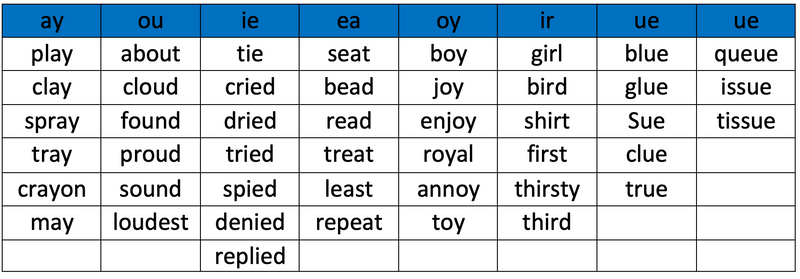Phase 5
Click on the below video clip to view Phase 5 sounds by West Acton teachers.
Click the following links for downloadable resources:
At West Acton Primary school we teach Phase 5 throughout Year 1. Phonics is taught daily for 20 minutes to the whole class but may be followed up by small group or individual teaching. At the end of teaching the whole phase the children are assessed to see whether they need consolidation of Phase 5 or are confident. Sometimes children are set by ability for phonics and may be taught by another adult than their regular class teacher.
Phonics is initially taught to help the children to read and decode words. As they progress the children then start to use the sounds they learn in phonics to write words. At first the words may be phonetically plausible and not spelt correctly but over time as children see more words spelt correctly and progress through the phonic phases they should begin to spell the words correctly.
Children entering Phase 5 will already be able to read and spell words with adjacent consonants, such as trap, string and flask. They will also be able to read and spell some polysyllabic words- lunchbox, laptop, and sandwich.
In Phase 5, children will learn more graphemes and phonemes. For example, they already know ai as in rain, but now they will be introduced to ay as in day and a-e as in make.
Alternative pronunciations for graphemes will also be introduced, e.g. ea in tea, head and break.
With practice, speed at recognising and blending graphemes will improve. Word and spelling knowledge will be worked on extensively.
Words that are referred to as Tricky words are also taught: oh, their, people, Mr, Mrs, looked, called, asked and could. These are not decodable and children have to remember how to read and spell them.
The National Curriculum 2014 also stipulates certain spelling patterns that must be learnt in Year 1:
- Adding the endings –ing, –ed and –er to verbs where no change is needed to the root word e.g. jumping, jumped, jumper
- Adding s and es to words (plural of nouns and the third person singular of verbs) e.g. cats, foxes, I eat , he eats
- Adding –er and –est to adjectives where no change is needed to the root word e.g. quicker, quickest.
- Adding the prefix –un, e.g unhappy, undo.













